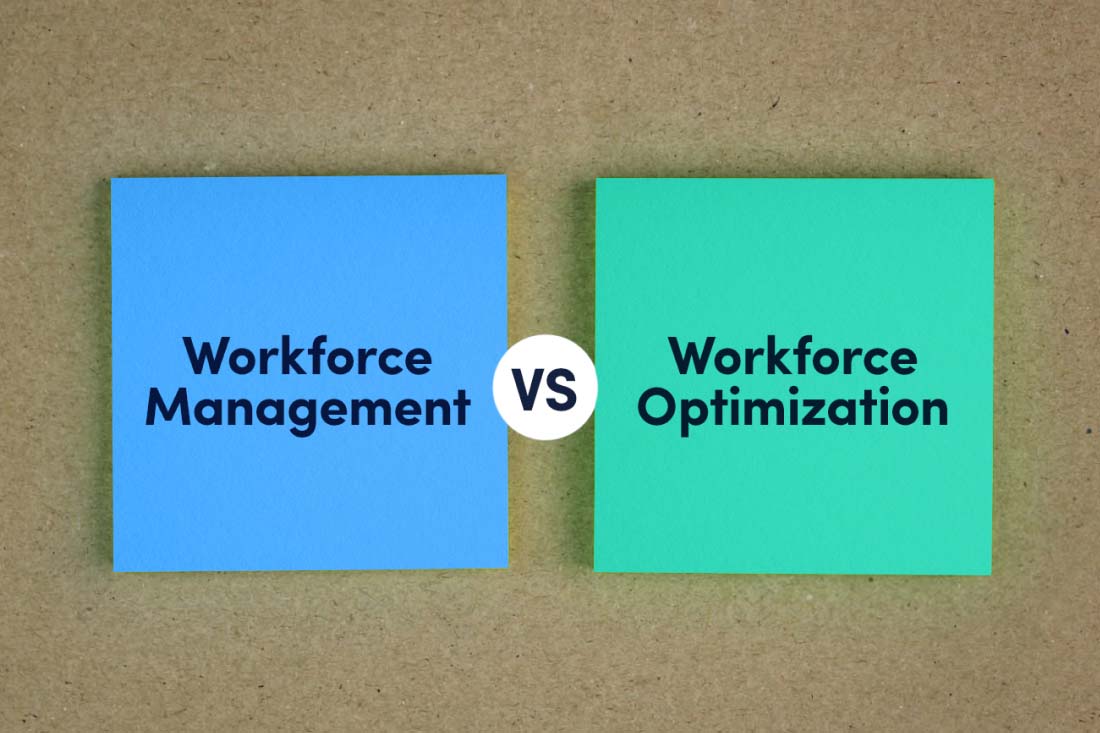Looking to improve profitability? You’ve probably heard about workforce management and workforce optimization. While these techniques sound similar, they serve different purposes — and impact performance in different ways. Let’s look at each one in more detail to better understand workforce optimization vs. workforce management.
What is workforce management?
Workforce management (WFM) is a set of strategies designed to ensure an organization is making the most of its workforce investments. Think of it as a method for ensuring you align the right people to the right responsibilities, at the right times — from peak periods to slow seasons. WFM features data-driven strategies to help you answer important questions such as:
- Are my team members overwhelmed or underutilized?
- How can we balance workloads more effectively?
- How do we maintain high levels of employee engagement and productivity?
The real magic of workforce management happens when you see beyond hours worked to understand how work gets done. It’s about empowering teams to do their best work by identifying and providing the right support and insights.
For an example of workforce management in action, consider the steps Ship Sticks took to improve customer service. When executives reviewed workforce data for hidden inefficiencies, they discovered contact center representatives had to open multiple apps just to service one customer. By streamlining those processes and tools, the company quickly improved customer service levels.
What is workforce optimization?
Workforce optimization (WFO) is a process for driving as much ROI as possible from existing people and resources while simultaneously lowering labor costs. It takes the principles of workforce management a step further by focusing on overall efficiency. Like WFM, workforce optimization relies on workforce analytics. But instead of focusing solely on how people work best, WFO allows you to see the bigger picture and answer questions like:
- How can we maximize existing talent before adding headcount?
- Which activities drive results and where are we losing time?
- Where is labor waste highest and what improvements are needed?
WFO allows you to spot and correct issues as they arise, opening the door to real-time coaching and correcting for faster, more profitable growth.
For an example of WFO in action, consider the case study of apparel manufacturer Fam Brands. Rather than diving headfirst into a new hybrid work model, executives first analyzed workforce data to confirm employees are more productive when working from home. Armed with the right insights, the company successfully expanded a pilot program to 500 corporate employees.
Workforce management vs. workforce optimization: 3 ways they’re different
Gaining true ROI from your workforce isn’t about tracking hours and outcomes — you need insights to help unleash the full potential of your people. Workforce management and workforce optimization go hand-in-hand to help you do just that.
1. Tracking vs. transformation
Workforce management provides the backbone for operational efficiency. Think of it as the nuts and bolts — monitoring hours and activities, aligning schedules and ensuring you have the right people in the right roles.
Workforce optimization, on the other hand, is about transformation. It allows you to go beyond the day-to-day to identify ways to help teams work smarter by understanding the underlying drivers of performance and productivity.
2. Reporting vs. strategic insights
Workforce management allows you to make data-driven decisions on a daily basis with real-time productivity insights. It answers questions like: Are workloads distributed fairly? Is anyone at risk of burnout?
Workforce optimization turns day-to-day data into a strategic powerhouse of long-term insights. It allows you to uncover untapped workforce capacity, eliminate inefficiencies and remove low-value work.
3. Immediate operations vs. long-term growth
Workforce management delivers immediate operational benefits. It helps you run a tight ship today, with precise scheduling and resource allocation.
Workforce optimization sets you up for long-term success, uncovering new ROI opportunities that allow you to develop strategies for more agility and innovation.
Workforce optimization vs. workforce management: why you need both
In today’s hyper-competitive business landscape, success hinges on how effectively you manage and optimize your most valuable asset — your people. Workforce management and workforce optimization work together to transform team performance and ensure exceptional customer experiences. Here’s how:
First, think of workforce management as the backbone of operational efficiency. Overcoming common workforce issues ensures day-to-day operations run as seamlessly and productively as possible. This tactical approach ensures you’re adequately staffed to meet business demands and quality assurance needs.
Workforce optimization takes this one step further to unlock more revenue potential. It allows you to make more informed decisions related to headcount and capacity planning, technology spending, remote work strategies and more. An effective WFO plan allows you to maximize existing people and resources before increasing spending.
Put simply: If you think of your organization as a high-performance engine, workforce management is the basic infrastructure keeping everything running smoothly. Workforce optimization serves as advanced tuning, turning your solid engine into a highly competitive performer.
Next steps: implementing WFO and WFM with ActivTrak
Ready to get started with workforce management and optimization? The sooner you start, the stronger the returns. Here’s a quick recap of the need-to-know basics when it comes to workforce optimization vs. workforce management:
| Workforce Management | Workforce Optimization | |
|---|---|---|
| Definition: | Set of strategies designed to ensure your organization makes the most of workforce investments on a day-to-day basis. | Process for driving as much ROI as possible from people and resources while simultaneously lowering labor costs. |
| Goal: | Ensure you have the right people in the right roles, at the right times. | Eliminate hidden inefficiencies to boost overall productivity and performance. |
| Key Metrics: | Workload balance, utilization, productivity trends | Headcount, labor capacity, technology costs |
| Best For: | Monitoring and improving productivity performance on a day-to-day basis. | Turning daily productive metrics into long-term insights and strategy |
Start today by taking an honest look at where you are right now. This means diving deep into your current processes, analyzing how work actually happens, and identifying gaps between your current performance and ideal state. Best way to do that? Use workforce management and workforce optimization software for real-time insights in both areas.
This is where ActivTrak comes in. Our workforce analytics software does the heavy lifting for you, turning complex workforce data into actionable insights. We help you move beyond guesswork by providing a comprehensive view of how your teams work, uncovering productivity patterns and opportunities along the way. Get started today with a free account, and request a demo to see how organizations like yours use it to manage and optimize their workforces.





